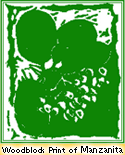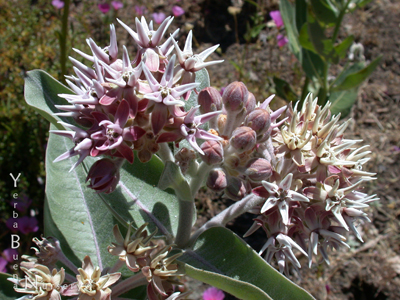

Please check out our new website at YerbaBuenaNursery.com
We are keeping this site alive while we continue to port all of the content over to the new site.
Please note. We are not actively maintaining this site. Prices and inventory are not current or correct.
For correct pricing and inventory, please visit the new site

Showy Milkweed
Article compiled by Anya Crane, Nursery Manager
Garden Guides | At Your Home Garden Design Service | We've Gone Native Planting Service | Garden Tune-Up Service
Why Plant Milkweed (Asclepias) in California?
The Monarch population is declining due to many factors, one of which is the increasingly limited access to Milkweed, the only larval food source of the Monarch caterpillar. In areas over-developed and over-landscaped these critically important Asclepias plants are becoming a less common occurrence. You can help re-populate the landscape and rebuild the Monarch corridor by planting local Asclepias in your garden!
Risks of Non-Native Milkweeds (Mexican Milkweed) in California
Mexican Milkweed (Asclepias curassavica) is easy to find in garden centers and mega-marts around the Bay Area, and is an alluring purchase due to its showy red and yellow flowers and misleading common name of 'Milkweed'. Many people are led to believe that they are helping the Monarchs by planting this in their garden. Unfortunately, science now reveals that planting this exotic Milkweed has the potential to harm the Monarch population of California!
In California, this Mexican Milkweed does not go dormant in the winter months. This can foster the growth of a parasite called Ophyrocystis elektroscirrha (OE) which replicate inside larvae and pupae and kill or fatally weaken developing butterflies. Butterflies who manage to pupate despite having this parasite can often spread the disease further during their shortened lifespan.
There is also speculation that Non-Native Milkweeds disrupt the butterfly's migration cycle by causing them to believe that they are in Mexico and can affect their ability to survive the California winter.
Help! I already have Mexican Milkweed. What Can I Do?
If you find that your Mexican Milkweed has brought a Monarch friend to your garden, don't panic! The true dangers of Asclepias curassavica begin to develop during the winter months when this Milkweed rebelliously chooses to not go dormant, promoting the development of the harmful parasite OE that kills Monarch butterflies.
Begin by planting the local, Native milkweed to promote future years of Monarch habitat in your garden. Then, as Fall approaches, cut back your Mexican Milkweed to the ground. (We recommend you take this action in October, but if you have let it grow further into the Fall cut it down as soon as you can.) At this point you should dig the plant out, and continue to keep an eye out for the distinctive shoots and leaves that may emerge near the site, removing them as they appear.
Continue planting for Butterflies, both adults and larvae of all breeds. With a small amount of effort and by selecting plants appropriate to your garden you can turn your home into a Native paradise that nature will enjoy for years to come.

Narrow Leaf Milkweed
You Say "Local" Milkweed, What Do You Mean?
There are fifteen Asclepias varieties native to the state of California, from the Oregon border to Baja California. Here in the Bay Area, two species of Asclepias are classified as the "priority species" and are the two we grow at Yerba Buena Nursery. Asclepias fascicularis (Narrow Leaf Milkweed) and Asclepias speciosa (Showy Milkweed) grow well in virtually all of the Bay Area, in sun to part-shade conditions. Both spread by seed and root, so that your garden will continue to develop a bountiful assortment of the plant over the years.
We recommend that you plant as many of these plants as your garden has capacity for, and encourage your neighbors to the same. It is only by developing a "corridor" of this vital resource that we can encourage the Monarch population to return in full, healthy force. One caterpillar can consume an entire Milkweed plant, so the more the merrier!
Be prepared for your Asclepias to go dormant in the winter. At that time, cut the dried plant stalks back to one inch sticks and leave yourself a sign or marker that you have planted Milkweed there. The next spring the growth will develop at or near the area. Both of the young Milkweed species we sell have a narrow leaf to begin, and the Showy Milkweed develops a broad leaf as it ages.
Should I Buy Monarch Caterpillars?
Say it with me: NO! Every year we get desperate phone calls from people who have purchased Monarch caterpillars and do not have sufficient food to feed them. So many caterpillars have gone to their grave with empty bellies because they were purchased rather than allowed to breed and grow in a natural environment. It takes time for an Asclepias patch to grow to support the ecosystem, and the only caterpillars you should have in your garden are the ones that are born there naturally.
Arboretums and "Butterfly Zoos" breed and raise butterflies completely in captivity and have the necessary infrastructure set up in advance to add caterpillars to their space. Home gardens are not the appropriate place for imported caterpillars, educational science experiment or otherwise.
Thank you for doing your part to promote the habitat of the Monarch butterfly!
Reference Sources:
- Monarch Joint Venture - Potential Risks of Growing Exotic Milkweeds
- Monarch Joint Venture - Q&A about research related to tropical milkweed and monarch parasites - Lots of additional information here!
- Xerces Society - Q&A about Monarchs and Asclepias
Published September 22, 2016
Garden Guides | At Your Home Garden Design Service | We've Gone Native Planting Service | Garden Tune-Up Service